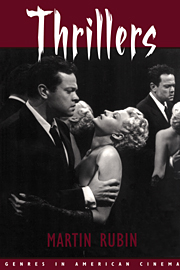Summary
In the mid-1980s, the movie thriller entered its classical period. This period was marked by the emergence of key, previously minor (sometimes even nonexistent) thriller genres, such as the spy film, the detective film, film noir, the police film, and the science-fiction thriller. A flamboyant visual style - characterized primarily by black-and-white cinematography, deep-focus lenses, low-key lighting, expressionist flourishes, and (especially after 1945) the increased use of location shooting - was evolved to convey the convoluted, charged world of the thriller. The period also witnessed the rise to prominence of the movie thriller's most famous practitioner, Alfred Hitchcock, discussions of whose work open and close this chapter.
Alfred Hitchcock and the Rise of the Spy Film
The popular appeal of horror films in the United States in the early 1930s (see Chapter 3), with their Europeanized settings and villains, can be attributed in part to a growing uneasiness regarding Europe - both as a source of the foreign “isms,” such as communism and fascism, that were becoming increasingly prominent in the political life of Depression-blighted America, and also as the site of a deteriorating international situation that threatened to drag the United States into a widely dreaded war (the American public was overwhelmingly isolationist throughout the early and mid-1930s). Horror films of the era present a mythic image of Europe as a source of decadence, rot, threat, madness - and, in the allegorical The Black Cat (1934), as a warhaunted powder keg about to blow sky high.
- Type
- Chapter
- Information
- Thrillers , pp. 79 - 118Publisher: Cambridge University PressPrint publication year: 1999

